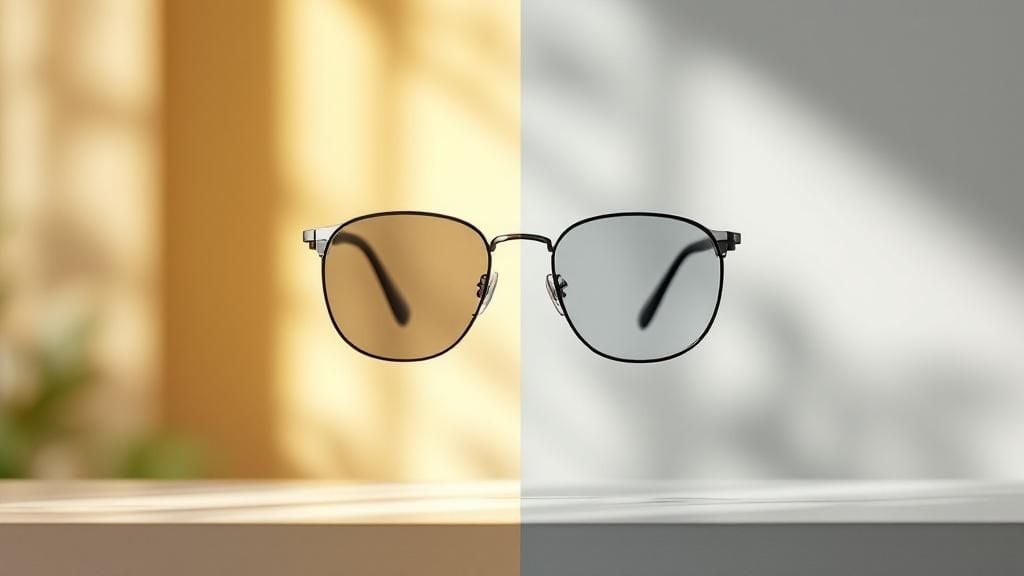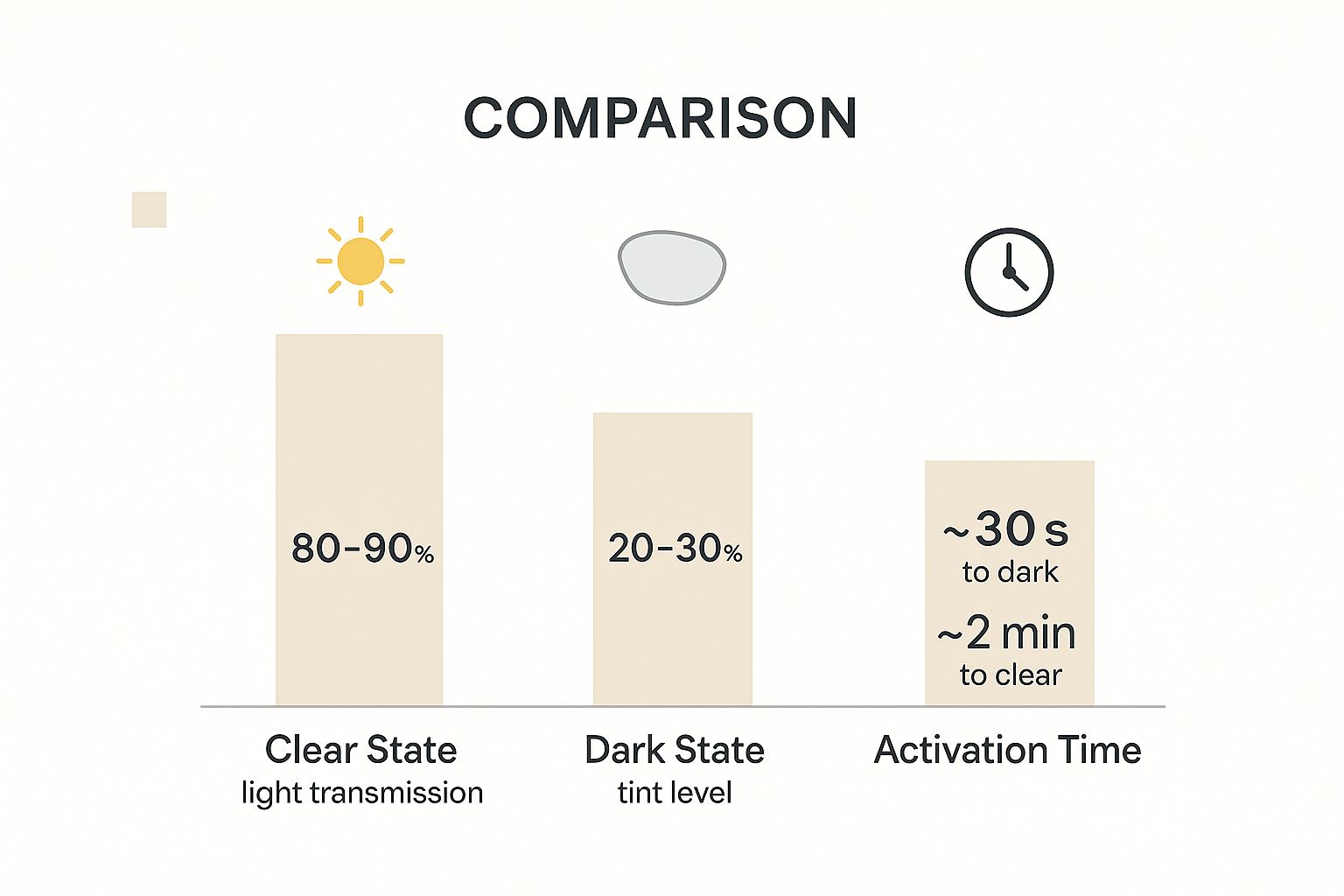If you've ever found yourself juggling a pair of prescription glasses and a separate pair of sunglasses while walking around Glendale Heights, you've probably wondered if there's an easier way. Photochromic lenses, which automatically darken in the sun and clear up indoors, seem like the perfect answer.
But like any technology, they have their trade-offs. The biggest hang-ups are their transition times, which can feel slow, especially when it's cold out. They also don't typically darken inside a car, which is a major drawback for many drivers. At iDoctor, your local optometry boutique in Glendale Heights, we help our patients weigh these pros and cons to find the perfect eyewear solution.
Are Photochromic Lenses A Good Choice For You?
Living in a place like Glendale Heights means you're constantly moving between different environments—from a drive down North Avenue to an afternoon at Camera Park. Finding eyewear that keeps up can be a challenge. That's where photochromic lenses, often called "adaptive" or "transition" lenses, come into the picture. They offer a pretty neat two-in-one solution.
This technology gives you clear vision and constant UV protection without ever having to switch frames. But is it the right call for your specific needs? The answer really boils down to your daily routine and what you value most in your eyewear. Getting to the bottom of the core photochromic lenses pros and cons will help you decide. Working with a professional is always a good idea, and you can learn more about what to look for when choosing the best optometrist near Addison in our guide.
At A Glance Performance
This is a quick snapshot of what you can typically expect from a modern pair of photochromic lenses.
As you can see, they offer excellent clarity indoors while providing solid tint and protection outside. It's the time it takes to switch between these states that is often the deciding factor for people.
Quick Comparison: Photochromic Lenses
Sometimes, seeing the pros and cons side-by-side makes the decision much clearer. Here's a quick rundown to help you weigh your options.
| Aspect | Key Advantage | Key Disadvantage |
|---|---|---|
| Convenience | You get your prescription glasses and sunglasses in a single frame, so you don't have to carry and switch between two pairs. | The change isn't instant. It can take a few minutes for the lenses to fully clear after you come back inside. |
| Protection | They offer 100% UVA and UVB protection at all times, whether clear or dark, helping reduce sun damage and eye strain. | Most won't darken inside a car because modern windshields already block the UV rays that trigger the transition. |
| Cost | You're often saving money compared to buying two separate prescription pairs (one clear, one sunglasses). | The upfront cost is higher than a standard pair of clear lenses, so it's a bigger initial investment. |
Ultimately, this table highlights the central trade-off: incredible convenience and protection versus slower reaction times and limited use while driving.
How Adaptive Lenses Protect Your Vision
It can feel a bit like magic, but the technology behind photochromic lenses is all about smart science. Packed into each lens are trillions of special, light-sensitive molecules. These tiny powerhouses are the secret to how your glasses can go from perfectly clear to a comfortable sunglass tint in moments.
When you walk outside, those molecules get hit with ultraviolet (UV) radiation from the sun. That exposure kicks off an immediate chemical reaction, forcing them to change shape. As they shift, the lens darkens to soak up the sunlight, giving your eyes instant relief and shade.
The Science of Safety
This automatic tinting does more than just make you comfortable—it’s a powerful defense for your long-term eye health. The core job of this technology is to filter out harmful solar radiation.
Modern photochromic lenses are built to:
- Block UV Rays Completely: They block 100% of both UVA and UVB rays, which we know contribute to serious eye conditions over time.
- Reduce Cumulative Damage: By wearing them consistently, you lower your lifetime risk of developing problems like cataracts and macular degeneration.
This constant, built-in defense is a huge plus for everyone, ensuring your eyes are shielded even on overcast days when sneaky UV rays are still a threat.
Smarter and Faster Transitions
Once you head back inside and get away from the UV light, the process simply reverses itself. The molecules shift back to their original state, and your lenses become clear again. If you remember older versions of these lenses that seemed to take forever to change, you'll be happy to know today’s technology is much more advanced.
Modern engineering has made these transitions incredibly smooth and quick. That means you spend less time waiting for your vision to catch up and more time seeing clearly and comfortably. Whether you’re looking at designer eyeglasses in Glendale Heights or just need a practical, everyday pair, this adaptive technology is a major step up in both convenience and protection.
Key Benefits of Photochromic Eyewear
Let’s be honest, the biggest win with photochromic lenses is pure convenience. Think about stepping out of your office onto Bloomingdale Road into that bright afternoon sun. Your glasses just darken on their own, shielding your eyes instantly. You don't have to stop, fumble around for your sunglasses, and switch pairs.
This one-and-done approach is also easier on your wallet. When you invest in a single pair of adaptive lenses, you’re not shelling out extra cash for separate prescription sunglasses. It's a practical, cost-effective choice for anyone who needs clear vision indoors and out.
Superior Eye Protection and Comfort
Beyond just making life easier, photochromic lenses are serious about protecting your eyes. They’re engineered to block 100% of UVA and UVB rays, giving you constant protection whether the lenses are fully clear, dark, or somewhere in between. That’s a huge deal for preventing the long-term damage sun exposure can cause.
This adaptive tinting also dramatically cuts down on glare, which means less squinting and more comfortable vision. By adjusting to the light around you, these lenses help reduce eye fatigue. If bright light often gives you trouble, you might find our post on effective eye strain headache relief helpful.
The demand for this technology is skyrocketing—the global market for photochromic lenses is on track to hit USD 9.65 billion by 2030. A big reason for this is growing awareness of eye health, especially with the CDC reporting that over 20.5 million Americans aged 40 and older have cataracts, a condition where UV protection is absolutely essential.
At iDoctor, we believe you shouldn't have to choose between function and fashion. You can get this incredible lens technology fitted into stylish frames from top brands like Gucci, Fendi, and Prada. It’s one of the best ways to keep your eyes protected without sacrificing your personal style.
Understanding Their Limitations and Drawbacks
While the benefits are compelling, it's just as important to look at the other side of the photochromic lenses pros and cons to figure out if they're a good fit for you.
For many people, the biggest surprise is how these lenses behave inside a car. Most modern windshields already block the very UV rays that trigger the lenses to darken. This means they won't tint effectively during your commute.
If you spend a lot of your day driving on roads like Glen Ellyn Road or the Eisenhower Expressway, you'll probably still want a dedicated pair of prescription sunglasses. To really dig into the best option for driving, you can see how polarized vs photochromic lenses perform in our detailed guide.
Temperature and Transition Speed
Another real-world factor is temperature. It actually influences how quickly the molecules in photochromic lenses can react.
- In Winter: During a brisk Glendale Heights winter, you might notice your lenses get darker than you'd expect and then take longer to clear up when you go back inside.
- In Summer: On the flip side, on a sweltering hot day, they may not get quite as dark as they would in milder weather.
It's also key to remember that the change isn't instantaneous. While technology has come a long way—they often clear in just a couple of minutes—there's still a noticeable adjustment period when you walk from bright sunlight into a dim room.
Knowing these trade-offs is crucial. By understanding the limitations, you can make a much more confident and practical choice after one of our detailed eye exams in Glendale Heights. Our team can walk you through the latest lens technologies designed to minimize these quirks and find the perfect match for your lifestyle.
When Are Photochromic Lenses the Right Call?
Figuring out if photochromic lenses are right for you really just comes down to your daily routine. For some folks here in the Chicagoland area, these lenses are more than a neat trick—they’re a perfect match for their lifestyle.
Picture a busy parent running errands. They’re constantly moving from a brightly lit grocery store aisle to the sunny parking lot. With photochromic lenses, their eye protection adapts automatically. There’s no fumbling for a separate pair of sunglasses while trying to buckle up the kids.
Even a student at Glenbard West High School can see the benefit. They get continuous UV protection during recess without having to remember to bring, and then keep track of, a second pair of glasses. The lenses darken the second they step outside, shielding their eyes from harmful rays.
A Perfect Fit for Life on the Go
These everyday situations really show who gets the most out of photochromic lenses. Think about someone who works in an office near Army Trail Road and loves taking their lunch break outside. Their glasses stay perfectly clear at their desk but instantly become sunglasses the moment they step into the sunshine.
It's this blend of convenience and constant UV protection that has driven the global photochromic glass lens market to a value of around USD 2.5 billion. And it's still growing. Modern versions of these lenses adapt to light faster than ever, making the whole experience seamless. You can discover more insights about this growing market here.
So, who are these lenses really for? They're an ideal solution for people who are:
- Constantly moving between indoor and outdoor settings.
- Particularly sensitive to bright light and glare.
- Looking for a single, cost-effective pair of glasses that does it all.
- Wanting UV protection that's always on, without a second thought.
These lenses truly combine practical, everyday function with powerful protection, which is why they’re such a great choice for anyone with a dynamic schedule. If you want to get into the nitty-gritty of different brands and options, read our guide on the best photochromic lenses to find your perfect match.
Here at iDoctor, we believe you shouldn't have to compromise. We can fit this amazing technology into high-end designer frames from brands like Cartier, Tom Ford, and Oliver Peoples, so you get both advanced function and incredible style.
Finding Your Perfect Pair in Glendale Heights
So, you've weighed the pros and cons and think photochromic lenses might be for you. What's next? The best way to know for sure is to see them in action. We invite you to stop by our Glendale Heights boutique to experience this adaptive technology for yourself and find the perfect fit for your lifestyle.
At iDoctor, we don’t just sell glasses; we help you find the right vision solution. It all starts with one of our signature 30-minute detailed eye exams to nail down your exact prescription. After that, our team can walk you through a curated collection of frames, from luxury brands like Cartier and Tom Ford to affordable classics like Ray-Ban and Coach.
Imagine pairing those high-tech photochromic lenses with classic frames from Cartier, Tom Ford, or Oliver Peoples. You get a look that's as intelligent as it is stylish. For more ideas, check out our guide on how to choose eyeglasses that suit you perfectly.
We believe great vision care should be within reach. That’s why we accept all major vision insurance plans. Our team is fantastic at helping you understand and maximize your benefits, so you never have to compromise on getting the best technology and style.
Whether you're coming from just down the road in Glendale Heights or making the trip from Carol Stream or Lombard, iDoctor is here to be your local partner for advanced eyewear. Let us help you find a pair of glasses that keeps up with every part of your day.
Frequently Asked Questions about Photochromic Lenses
Do you offer photochromic lenses in designer frames like Cartier or Gucci?
Yes, absolutely! At iDoctor, we specialize in fitting advanced lens technologies, including photochromic lenses, into our curated collection of luxury eyewear. You can find frames from Cartier, Gucci, Tom Ford, Fendi, and many other top brands. We believe you should never have to sacrifice style for function, and we can help you find the perfect pair of designer eyeglasses in Glendale Heights.
I live near Glendale Heights. Can I use my vision insurance for these lenses?
Yes, you can. iDoctor is proud to accept all major vision insurance plans. Our team is experienced in helping patients from Glendale Heights and surrounding suburbs like Carol Stream and Lombard understand and maximize their benefits. We'll work with you to ensure you get the best value on your photochromic lenses and frames.
How long does it take to get used to photochromic lenses?
Most people adjust very quickly, often within a day or two. The transition from clear to dark and back is much smoother with modern lenses. The key is to remember they react to UV light, so they won't darken in your car. If you're new to them, our team will provide tips to make the adjustment seamless when you pick up your new glasses from our Glendale Heights boutique.
Ready to see if photochromic lenses are the right choice for you? Schedule your comprehensive eye exam at iDoctor today and let our experts in Glendale Heights help you find the perfect blend of style, comfort, and protection.
Explore Our Services and Book an Appointment at iDoctoril.com









